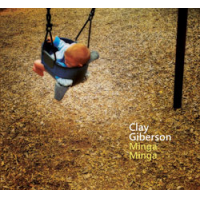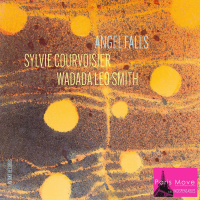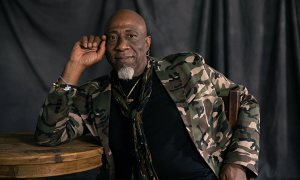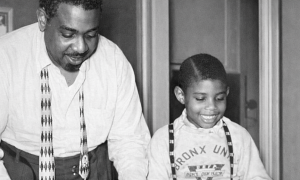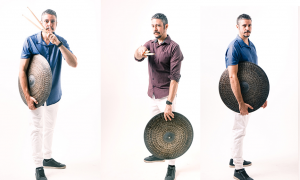Home » Jazz Articles » Interview » Ron Aprea: On John Lennon, Jazz Legends, And Life In Music
Ron Aprea: On John Lennon, Jazz Legends, And Life In Music
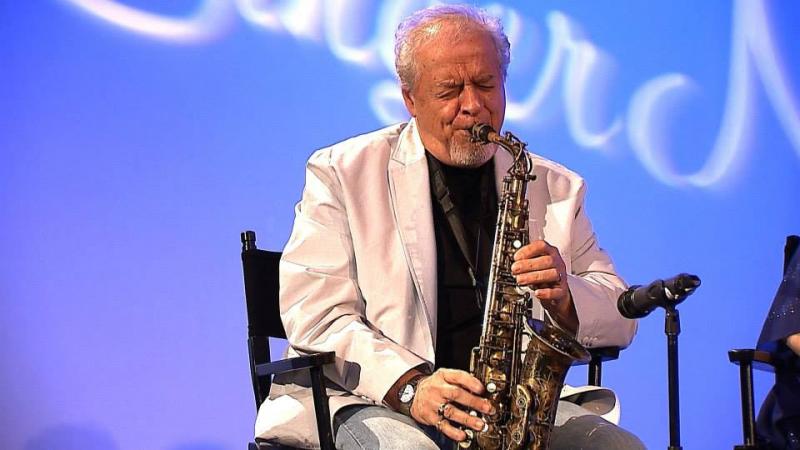
The biggest challenge was to not fall into [a musical] "No Man's Land." The scary part was [the possibility of] pleasing nobody because I'm doing a jazz album with rock songs or pop songs...
That little episode may sound like it's coming straight out of some fictitious film script, but it's actually biographical in nature. It's part of Ron Aprea's story, and his is a story that deserves to be told. Over the course of the last four-plus decades, Aprea has been an important and under-appreciated figure on the jazz scene, leading his own bands and performing at various times with vibraphone pioneer Lionel Hampton, Latin legend Tito Puente, the great Woody Herman, trumpeter Nat Adderley, and numerous other jazz giants. And while part of his under-the-radar standing can be connected to his lack of leader dates, having only one album to his name prior to 2013, he's making up for that these days. Aprea turned plenty of heads with Remembering Blakey (Self Produced, 2013), a hard-bop based sextet date that cooks in all the right ways, and now he's ready to turn some more with the long-awaited Ron Aprea Pays Tribute To John Lennon & The Beatles (Self Produced, 2015). This conversation started there, but Aprea was open to discussing a variety of topics during the interview.
All About Jazz: How did your latest album come about?
Ron Aprea: I recorded with John Lennon in 1974. I was on an album called Walls And Bridges—the first album he used a horn section on after he left The Beatles. I was part of that horn section—the "Little Big Horns." There were five horn players [in that group]—Steve Madaio was on trumpet, Bobby Keys was on tenor, Frank Vicari was on tenor, Howard Johnson played baritone, and I played alto. It was a pretty successful album for John, and he had a couple of number one hits on that album for the first time as a solo artist, so it turned out to be a pretty nice thing. So that's my connection to John Lennon.
Over the years I've been thinking about this idea, but what inspired me to do it was [what happened when] I recently did a concert at B.B. Kings [in New York City]. I was invited to come and play one of the tunes from the Walls And Bridges album. After my segment, a young, pretty lady named Ginger Broderick got a pass and came backstage. We were talking, and it turns out that she's a TV host. We stayed in touch, and I sent Ginger a copy of Remembering Blakey, and she invited me up to do her show. Knowing that she's a Beatles fan, I arranged a couple of Beatles tunes with a jazz style. I put a rhythm section together and we did "Imagine" as a jazz bossa, and we did "Happy Xmas." I had Marcus McLaurine on bass, Cecilia Coleman on piano, and Jonathan Mele on drums. We opened the show, and after my segment, when I went over to do my interview with Ginger, I noticed that Ginger was in tears. Hearing these Beatles songs got her emotional, so I'm thinking, "gee whiz, if I can make people cry with this music, maybe it's time to do the album since I'd been putting it off for forty years." That inspired me. And seeing that reaction, even to a jazz version, kind of surprised me. So there was that...along with something that Marcus said after the session. He said, "You know, John Lennon never really worked with a lot of people. He only worked with The Beatles and a handful of other musicians ...so it's a pretty unique thing, and you should seriously consider doing a tribute to John Lennon. That might be something that's nice, and the story that goes with it is kind of cool." So, between Marcus and Ginger, I was inspired to go home and start working.
AAJ: How long were you working on the album from conception to completion?
RA: About a year-and-a-half. It took me a couple of months to just go through all of the material. I have every piece of material that he wrote. I went through every song, one by one, and played them for a while until I felt fairly comfortable with them, trying to figure out which ones would work in the style that I had in mind. So when I finished that process, I almost felt that I was home.
AAJ: Was there ever a thought about making it just a Walls And Bridges-related project or did you want it to be more expansive, covering his entire solo career and The Beatles?
RA: No. And there's only one tune on the album from Walls And Bridges. The rest is a hodgepodge from various periods of his life. I chose a lot of songs that he co-wrote with Paul McCartney; "Imagine," of course, [is also on the album], but that wasn't on Walls And Bridges. So the only Walls And Bridges tune is "Whatever Gets You Thru The Night."
AAJ: The number one hit.
RA: Yeah, that was his big hit.
AAJ: Now, you ended up with twelve tracks on the album. Did you have more going into the project or was it always those twelve?
RA: It's a good question. There was one song that I just couldn't get to work. When I'm recording and when I'm putting tracks down, if something magical doesn't happen in the course of that song, I take it out. I hated to do, but I couldn't get "Hey Jude' to the level that I wanted it to get to. I'm not sure exactly what it was, but it just wasn't gelling. I tried a few different things, and I brought in different people to try different things, but I just couldn't get it to work...so "Hey Jude" was deleted from this project.
AAJ: What was the biggest challenge in putting this album together?
RA: The biggest challenge was to not fall into [a musical] "No Man's Land." The scary part was [the possibility of] pleasing nobody because I'm doing a jazz album with rock songs or pop songs...and, there's always the fear of the jazz people thinking it's too commercial and the rock people thinking it's too jazzy. So, it's a little scary. And also, I knew even before I went into this project that I wanted to use a string section [and that was a risk and a challenge]. I know the critics killed Bird when he recorded with strings and they killed [Stan] Getz when he did his Focus album, and they killed Cannonball [Adderley] when he did his thing with strings. So, I'm aware of that, but I was really hearing strings and I wanted to go with a string section.
AAJ: How did the experience of putting together this one differ from Remembering Blakey?
RA: Remembering Blakey is kind of straight, in-your-face hard bop, and this is a bit more lush in style. A lot of the ballads are lush and pretty. They're sort of Charlie Mariano-ish as opposed to Blakey's style. One of my favorite albums is A Jazz Portrait Of Charlie Mariano, with Don Sebesky arrangements, so I was thinking a little bit about Sebesky when I was writing these charts. I was trying to stay true to the melodies while remaining creative. On a couple of tunes, I got away from the melody a little bit, but, for the most part, I made up my mind that I wasn't going to distort or alter the melodies. That, immediately, put some constraints on how I was thinking about this project.
AAJ: Are there any plans to do this music live?
RA: There are no plans as of now, but I'm getting calls asking me to do it live. I also often get calls about performing Lennon's music at other events. In fact, just today, I got a confirmation that I'll be performing and talking about my experiences with John Lennon at the 2015 Chicago Beatlefest. I'll actually be performing with one of the bands there, doing, of course, "Whatever Gets You Thru The Night," and I'll be autographing CDs, and hopefully, selling some. There's also another big one coming up in New York...and it looks like I've been invited to that one as well. And again, I'm really happy and pleased that the people in the rock genre have welcomed me with open arms. I can't wait to get out there. That'll be a lot of fun. Regarding my album and the possibility of performances, I have to say that putting the studio band together for a live performance would be fun, and I'd love to do it, but the budget would have to be substantial because it's a big project. There are probably fifteen or sixteen people on this album. If the project continues to be well-received, and people come up with a budget, I'd be happy to take the sixteen pieces out and perform.
AAJ: Going to the topic of budget, since you brought it up, I believe that you funded this and Remembering Blakey through a fan-funding website—Kickstarter, right?
RA: Not Remembering Blakey. That wasn't funded through Kickstarter, but this album was. We reached our goal, and man was it nice to have a little budget to work with. It wasn't huge, but I was able to bring in the people that I wanted. That's pretty cool and I was really happy about that. And [it helped with] all the little things, like getting the right radio promotion people, and getting a publicist. So, that [form of funding] really helps.
AAJ: Speaking of that, can we discuss the musicians you brought in? You had a few carryovers from the Remembering Blakey project, some very notable names—Brian Lynch on trumpet and Vince Cherico on drums, to name just two—and some family mixed in there. How did you come to choose these players and how did you get connected to them?
RA: That's another great question. I first heard Brian Lynch when my wife—vocalist Angela DeNiro—and I were co-hosting a radio show on WSHR here on Long Island. We were doing a Thursday night show from 5-7PM called Rush Hour Rendezvous...and we always had certain radio promoters that were sending us packages of CDs to play on the show. One of them sent me an album that was called Mile High Jazz: Live In Denver, with Phil Woods and Brian Lynch on it. So I'm thinking, "well, who the heck is Brian Lynch." I knew Tom Harrell as Phil's trumpet player. So we played the first cut, and it was like an up-tempo blues, and man, Brian Lynch was just killing it. Me and Angela were sitting there going, "who's this trumpet player?!" So, that was in 1998 or 1999. We did that show for a couple of years, and...I thought, someday, I want to do a project with Brian. I actually did a couple of projects with him [prior to this new album]—some vocal albums that I produced—but we never did a serious straight ahead jazz album together, so I thought this was the time to bring in that killer trumpet player. He's a great player and a great guy.
AAJ: And Vince Cherico? How did you get connected to him?
RA: Well, I've known Vince for a long time. We've probably done five or six recording projects together. I met him through [trumpeter/producer/publisher] Don Sickler, a good friend of mine. Vince has always been one of my favorite drummers. In fact, I knew I was going to be doing some Latin on this album, and he's a great Latin drummer as well as a great straight ahead drummer. He's also great in the studio, he's a great reader, and a beautiful guy. And from past experiences, I knew he'd be perfect for this project.
AAJ: And guitarist Dom Minasi is on the album. I think some people will be surprised to catch him playing in a much more conventional way than they're accustomed to hearing him in recent times.
RA: Yeah, Dom's on one track. I had to rein him in a little bit because he's a very high energy, avant-garde, outside kind of player. We did a lot of playing together back in the '60s and '70s when a lot of us jazz players were kind of on the outside. There was a lot of modal playing going on, and Dom's a great modal player. So we did a lot of playing together back then, we had some groups, we did some recording together, and we've been friends for a very long time. But, on this project, I brought him in to play acoustic guitar on one track. It's the last tune on the album—"Goodnight." It's just Angela doing the vocal—it's the only vocal on the album—and Dom, and myself. So we brought him in to do that track with Angela, and it took all of fifteen minutes; he nailed it. I knew he'd be perfect for what I was looking for. He's a great acoustic guitarist and he gets a beautiful tone out of his guitar.
AAJ: Agreed. He sounds great on the record. Going back to Walls And Bridges for a minute, and your experiences with Lennon in 1974, can you talk about what those sessions were like?
RA: We can talk about that [or view it] in two parts [or stages]. The first few sessions were really strange and stressful for me. We had five horns, as I mentioned before, and no arrangements. I initially thought Steve [Madaio] was kidding about that. When I got up to the sessions, I said, "Steve, can I take a look at the alto book before we get started?" At that point, he looked at me with this funny look, and his eyes got kind of big, and he got kind of nervous and started playing with the valves on his trumpet. Then he said, "There's no music." I said, "Stop kidding around, man. Let me take a look at the book." I really thought he was kidding. Then he repeated that there was no music, but he said, "It's cool, it's cool." He said, "Just listen to me and it gets easier as you go."
It turned out that there was no music and it was all head stuff. Steve, of course, toured with all these rock bands—The Paul Butterfield Blues Band, Stevie Wonder, and the Rolling Stones—and they never used [written] arrangements. They made up all of those horn parts, and they played them every night, so they just memorized them. They worked them out on the bandstand. So that's what the plan was for this session. I think I figured out later why there were no arrangements: I think, probably, because Lennon didn't trust putting his music in the hands of an arranger. He wanted complete control over the project, and he wanted to sit there and kind of dissect everything that we played, and choose what he liked, and discard what he didn't like. And it took a lot longer and it cost him a lot more money to do it this way. There was a lot of hitting and missing going on, especially in the early sessions. So, that's pretty much the scene in the studio. But Steve was right: it got easier as we went along and I found myself becoming pretty comfortable, even contributing some ideas and adding to the horn parts. In the early stages, during the first couple of sessions, I really thought about splitting...but it did work out and I'm glad I did it.
AAJ: Were there any particular grains of wisdom—either on a musical or personal note—that you took away from Lennon at that time.
RA: I don't know about "wisdom." I don't know if I'd use that word. "Inspiration" is a better word. He was a real motivator. He was like a cheerleader and he was complementary. He seemed really happy, he had tremendous respect for the musicians, and he was easy as heck to work with—one of the nicest bandleaders I've ever worked with. That had a lot to do with why I didn't leave. He was just a great guy.
AAJ: Now, you've been playing for decades, you've played with some of the biggest names in jazz, and you have tremendous experience, but it seems like you're just starting to take off as a leader on record in recent years, with two of the three albums you've recorded under your own name coming out within the past three years. What is it that's really driving you to start recording more as a leader now?
RA: Well, I'm recording more as a leader, but I've been a bandleader pretty much from the beginning. I started out with my own rehearsal band way back in the early '60s, so being a bandleader is nothing new to me. Being a recording bandleader is kind of new. I'm comfortable producing and writing, and I think, at this stage in my career, I'm ready to come out front and present some music. It's a tough question, but I think my wife might have a lot to do with pushing me. Angela has a lot to do with why these things are all happening, and so far it's been positive and she couldn't be happier for me, so that's cool.
AAJ: Are there any plans for any new albums in the near future?
RA: I don't know. Right now I'm kind of catching my breath after a year and a half with this. I think it's probably time for another project with Angela. She's a great singer and she has three albums out on her own, and I wouldn't mind doing another vocal album. I love writing for vocalists, and especially a good vocalist like Angela. She makes my arrangements sound great.
AAJ: Speaking of arrangements: where does your training come from in terms of arranging, and is there anyone, in particular, whose style you lean towards or are inspired by?
RA: Way, way back in the late '50s, I loved Basie's band, and I used to go down to Birdland whenever Basie's band was in town. They were always in town for a couple of weeks around the holidays. I was really in love with Frank Foster's arrangements and playing. And there was this camera girl coming around and wanting to take our pictures. I was with two of my friends, and I said something like, "Well, if you can get Frank Foster to come over, that would be cool and then you can take our picture." So she leaves, and I figured that's the end of that...but after the set, she comes walking back with Frank Foster. She takes the picture and, of course, sells it to us, and that was how I met Frank.
That started a four decade friendship between Frank and myself. Frank was a big inspiration to me. He played at my wedding, I played in his band, he played in my band, and we got together to play duets. So we became good friends and he was my favorite arranger. So, even in those early days [of our friendship] in the late '50s, he would invite me up to his house and give me his scores. I had a rehearsal band at that time, and we were playing stock arrangements, so I asked Frank if he had any old arrangements that he might want to contribute to my rehearsal band. But he started giving me everything—all these new arrangements, things they were just recording. And I would go home and copy them. That's how I learned how to write. I had all the records, and now I had all the scores. So I was able to see what caused that to happen. I'm listening to these beautiful ensembles and these sax solis, and now I'm also looking at the scores. They have books on this now where they analyze scores—like Inside the Score [by Rayburn Wright]. So this was kind of like that [process with the book], only forty years before Inside The Score came out. I would sit there and look at the scores and listen to the music, so that's how I really learned how to write. And [I learned] from playing them, too. Something happens when you play them. You kind of learn to write from playing good arrangements. So part of it was playing and part of it was analyzing the scores. So I can say I'm self-taught, but I'm really not. These were Frank Foster's scores that I had the privilege of studying.
AAJ: Now, you've discussed Frank Foster at length, and you briefly mentioned Lionel Hampton. What was it like to work with Hampton? What was the overall experience like?
RA: I loved Hamp. I joined his band for the first time in 1969. It was a small band: just alto, tenor, and trumpet. I absolutely loved it. I had played with hipper bands, where the music and the arrangements were slicker and better, but there's something special about connecting with an audience, and his band always connected. I was actually surprised that he liked my playing because, as I mentioned earlier, I was pretty avant-garde—I was into Eric Dolphy, you know—and I was playing with a lot of energy. But Hamp seemed to like that. In fact, [that showed when] he would open stuff up and bring soloists down to play. He'd bring the trumpet player out for a couple choruses, and then the tenor player would play, and he'd save me for last all the time because I'd always go nuts. For the longest time I couldn't figure out why he liked my playing, because Hamp was a real bebopper. If you ever hear any of his serious recordings where he records with Oscar Peterson, it's like listening to Charlie Parker on the vibes. He was just a great player. Of course, he would do his commercial thing. He was audience-conscious, and he would clap on one and three, and he would do things that musicians would put him down for, but he was really a great player. So I [eventually got my answer about] why he liked my playing: one day we're on the bus, and we're talking, and he says he's an Eric Dolphy fan. He said, "I love Eric Dolphy," and he starts humming his stuff. So that was my relationship with Hamp. Our friendship lasted until the day he died. He actually did me a big favor. I did an album with Angela called Swinging With Legends (Self Produced, 1998), and it was with my sixteen piece band. The legends were Lionel Hampton, Frank Foster, and Lew Tabackin—three old friends of mine.
AAJ: That's quite a line-up.
RA: Yeah. And Hamp and Frank didn't even want any money. They just did it as a favor. They were just trying to help me out. They were such great friends. And, of course, Lew Tabackin was great. I toured with him in the [Les] Elgart band and we've been friends ever since. So those were the people on that album.
Frank Foster and Lionel Hampton were the people that inspired me. And people would always ask, "Why would Frank Foster just give you all that music like that?" And I 'm thinking, "Well, he liked me." I guess Frank saw something in me that he liked. I was kind of shy and he was kind of shy. We just connected, and he decided that I was going to be a guy that he was going to share his music with, and, man, I'll be forever grateful for that.
AAJ: You said you started with Hampton in '69. How long were you with him?
RA: I toured with Hamp a lot. But it was the tail-end of the big band business, I guess, so we weren't on the road 365 days a year anymore like they were prior. He would do a tour, then come back into town for a few weeks, and then do another tour, so I was doing most of those tours right up until the time I did the [Walls And Bridges ] album. From 1969 to 1974 I did a lot of work with Hamp.
AAJ: And then did you go back on the road after Walls And Bridges?
RA: Yeah, I toured with a bunch of bands. Woody Herman's band was before that, but I toured with a really good gospel band with Nat Adderley after that. I got to play with Nat at the Apollo Theater, and that was one of the big kicks of my career. I also played with Tito Puente's band right through the '70s. I wasn't a regular with that band—I was subbing for his lead alto player, Don Palmer, and the tenor player, Dick Mesa. That band was working seven nights a week, so those guys were killing themselves. They couldn't do seven nights, so I was subbing for both of them. I was probably doing two or three nights a week with Tito's band. The good part about that was that that band didn't travel. They stayed around New York, and that was a great band.
AAJ: It seems that versatility has really served you well. Do you think that that's one of the key assets that musicians need to have in order to make it today?
RA: It's a different world today. I'm not really sure what they need today. But you can't really specialize. I mean, I love jazz, but even the best jazz players today are teaching at universities and taking private students. It's pretty hard to make a living playing jazz, so you really have to be versatile. Either that or you're going to be working a day job.
I've always taught my students—saxophone players—to also play flute and clarinet. And then maybe even a double reed if they really want to do Broadway shows and studio work. I think it's important to be versatile. Not just with instruments, but be open-minded about music. Be able to play in all genres. I was fortunate. I played the Latin scene, I played the rock scene, and when I was thrown into the Lennon thing, I was able to function. And I certainly feel comfortable playing swing music, and even Dixieland. My preference is, obviously, what I'm doing now, but you have to have an open mind unless you want to be a part-time player. If you want to get into the business, you better be prepared and you better be versatile.
I think, in this day and age, it's as tough as it ever has been for young kids [interested in going into music]. There are some great talents coming out of these colleges, but where do they go? There are fewer opportunities with electronics [taking over part of the business]. Even Broadway shows are using a lot of synthesizers, so many don't have full orchestras like they did years ago. I used to do the circus, and I did it for years. It was a great gig because it was in January and February, during the slow season. And it was always a great band. All of the best New York players were doing the circus. And then they started to phase us out. They were able to somehow bring in synthesizers. I was part of that band when it was being shrunk...and I would be sitting up there in the band room and I didn't even have to bring my horn. I didn't have to play. They had some kind of deal with the union. They didn't even need the players, but we sat there and got paid until it was eventually all phased out. And I remember walking down a corridor when I was there, while the show was going on. I just wanted to hear what it sounded like without the horns: it was loud—as loud as it ever was—but it was kind of sad. I think the people that were sitting there probably felt that something wasn't right, but probably didn't know what it was. It didn't have the energy that it had before. And sadly, that's somewhat typical of what's going on in the music world these days.
AAJ: Right. That's why I think it's important for people—aspiring musicians, especially—to differentiate between music and the music business. They're very, very different things, and I think a lot of people blur the lines or confuse that.
RA: Exactly. I did another interview recently, and those were my exact words. If I have any advice for up-and-coming musicians, it would be to always remember why you're playing. When I started playing, I certainly wasn't thinking about making a million dollars. I didn't know if I'd ever be able to make a living at this, even as a part-time musician. I played because I loved music. And when you do get into the business, [you need to] be able to separate music from the business. Don't let the negatives of the business effect your music. Create playing situations. I've had jam sessions down here [at my house] for years. Friends of mine come over once a week. We pick a rhythm section and we just play music, just to keep in shape and play good music. And you separate the music from the business that way. It has nothing to do with "working." It's just pure music. And you create those kinds of situations to keep yourself sharp, and to stay in tune, and to grow. I think it's important. Make things happen. Pick up the phone. Call friends to play. Play duets. Stay active.
AAJ: I think many people are probably just waiting for the phone to ring, waiting for that all-impressive gig or big break instead of just doing what you said.
RA: Right. And often—not that you do it for this reason—one of the guys at one of these sessions will say, "I've got something coming up next week, and maybe we can do it with this group." Even at my big band rehearsals, somebody will say, "Hey, Ron, what are you doing next Thursday? I've got a gig for you." So it's like you're in the environment. You're around all of this. You know, you don't get jobs from the public very often. You get jobs from the musicians. Be around musicians, be playing all the time, and make sure you're at your best. Don't you dare even pick up your horn at a party if your chops are down. Stay in shape and stay active. Create things if things aren't being created. Create them yourself. I've always done that. Like I said, friends come over and you just play. There's something so beautiful about not worrying about how many people are in the club, or if the club owner's going to complain about not making enough money that night, or whatever [the problem could be]. Instead, we just get together in my studio, and it is pure music, and we just let it go without any fear. And I suggest that all of these young, aspiring players do that...and find another place separate from the business where they can let it go, and grow, and have fun playing, because that's why we're doing it.
AAJ: Is there anything that you haven't done yet in your career that you still hope to accomplish?
RA: I haven't made a million dollars! I'd like to accomplish that! I'm kidding, of course, because money has never been my motivation. I think what I've yet to accomplish would be to be able to afford my own band, pick the best players, and go on tour and travel around the world playing music with those world class musicians. I've done tours like that, but not on a steady basis. I'd like to be able to afford my own band and do more of what I'm doing now. [Other than that], there's nothing that I can think of.
AAJ: Is there anything that we didn't discuss yet that you'd like to mention?
RA: There is one thing that we didn't discuss that I'd like to mention. With this John Lennon project, we're actually donating two dollars from the sale of each CD to a really great organization called Aid for Kids. It's a world-wide [charitable] organization that works with struggling kids all over the planet. We interviewed quite a few charities, and these people really impressed us [the most]. 98% of their donations go directly to the kids and they're able to do that because their help is all volunteer-based. If people go to their site—aidforkids.org—they'll see what an amazing group of people these people are. So I just wanted to include a mention of that. In the spirit of John Lennon, we're going to be working with struggling kids, and I thought that was cool.
Photo Credit: Film Crew at GingerNewYork TV
Tags
Ron Aprea
Interview
Dan Bilawsky
Lionel Hampton
Tito Puente
Woody Herman
Nat Adderley
Howard Johnson
Marcus McLaurine
Cecilia Coleman
Jon Mele
Charlie Mariano
Don Sebesky
Brian Lynch
Vince Cherico
Phil Woods
Tom Harrell
Don Sickler
Dom Minasi
oscar peterson
lew tabackin
Don Palmer
PREVIOUS / NEXT
Support All About Jazz
 All About Jazz has been a pillar of jazz since 1995, championing it as an art form and, more importantly, supporting the musicians who make it. Our enduring commitment has made "AAJ" one of the most culturally important websites of its kind, read by hundreds of thousands of fans, musicians and industry figures every month.
All About Jazz has been a pillar of jazz since 1995, championing it as an art form and, more importantly, supporting the musicians who make it. Our enduring commitment has made "AAJ" one of the most culturally important websites of its kind, read by hundreds of thousands of fans, musicians and industry figures every month.




